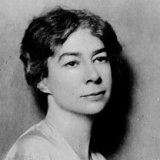Analysis of Epitaph
Sara Teasdale 1884 (St. Louis) – 1933 (New York City)
Serene descent, as a red leaf's descending
When there is neither wind nor noise of rain,
But only autum air and the unending
Drawing of all things to the earth again.
So be it, let the snow fall deep and cover
All that was drunken once with light and air.
The earth will not regret her tireless lover,
Nor he awake to know she does not care.
| Scheme | AXAX BCBC |
|---|---|
| Poetic Form | Quatrain (50%) |
| Metre | 01011011010 1111011111 1101100010 1011110101 11110111010 1111011101 011101010010 1101111111 |
| Closest metre | Iambic pentameter |
| Characters | 342 |
| Words | 69 |
| Sentences | 4 |
| Stanzas | 2 |
| Stanza Lengths | 4, 4 |
| Lines Amount | 8 |
| Letters per line (avg) | 33 |
| Words per line (avg) | 8 |
| Letters per stanza (avg) | 134 |
| Words per stanza (avg) | 34 |
Font size:
Submitted on May 13, 2011
Modified on April 27, 2023
- 21 sec read
- 294 Views
Citation
Use the citation below to add this poem analysis to your bibliography:
Style:MLAChicagoAPA
"Epitaph" Poetry.com. STANDS4 LLC, 2024. Web. 29 Apr. 2024. <https://www.poetry.com/poem-analysis/34504/epitaph>.


Discuss this Sara Teasdale poem analysis with the community:
Report Comment
We're doing our best to make sure our content is useful, accurate and safe.
If by any chance you spot an inappropriate comment while navigating through our website please use this form to let us know, and we'll take care of it shortly.
Attachment
You need to be logged in to favorite.
Log In